Developing Integrated Multi-Trophic Aquaculture systems for commercial salmon hatcheries
Published: April 7, 2017
By: Thierry Chopin, Stacy Murray and Hamid Khoda Bakhsh
/ Canadian Integrated Multi-Trophic Aquaculture Network, University of New Brunswick, Saint John, Canada.
Integrated Multi-Trophic Aquaculture (IMTA) is a flexible concept on which many variations can be developed and should not be viewed as confined to open-water, marine systems.
For instance, Atlantic salmon reared for commercial use spend the early part of their life cycle in freshwater, often in land-based, closed-containment hatcheries before being transferred to open-seawater sites.
Consequently, the principles of IMTA can also be applied to land-based, closedcontainment and freshwater systems (also called aquaponics). What is important is that the appropriate co-cultured organisms are chosen at multiple trophic levels based on their complementary functions, as well as their economic value.
As in saltwater operations, the nutritional benefits of the water that has been used to grow fish need to be considered. Rather than treating and releasing this water and loosing this potential, wastewater becomes a source of irrigation water, nutrients and media for additional crops.
LAND-BASED IMTA
Over the last two and a half years, a comprehensive field and laboratory feasibility study was conducted to investigate the potential for developing land-based freshwater IMTA (or FIMTA) systems for Atlantic salmon hatcheries operated in New Brunswick, Canada, by our industry partner, Cooke Aquaculture Inc.
Both flow-through and recirculating facilities were assessed to design the most appropriate systems based on water quality, nutrient loading, flow- and discharge characteristics. Also important are nutrient concentrations and bioavailability, temperature, light, space availability, plant specific growth, absorption requirements, and economic viability and markets. The analyses indicate that recirculating hatcheries are more valuable candidates for FIMTA systems than conventional flow-through hatcheries.
We built a temperature – and light-controlled pilot scale FIMTA system at the University of New Brunswick in Saint John, New Brunswick to test the growth and nutrient removal capabilities of a variety of plant species in hatchery conditions. Effluent was collected from a commercial salmon hatchery and nutrient levels were measured before and after flowing through the plant grow-beds to identify the capability of the system to reduce nutrient levels.
Salmon hatcheries typically operate with water temperatures between 10 and 15°C, thus the selected plant species will most certainly be different from those used in the most advanced aquaponic systems developed so far with tropical fish (such as tilapia) in warmer water.
In our case, the selected plant species have to be hardy, grow well and have appropriate nutrient absorption capacities at low temperatures, and be of commercial value (as edible, ornamental or medicinal plants, for example). Based on these requirements, the plants tested so far, with positive results, have been: watercress, Nasturtium officinale; leaf lettuce, Lactuca sativa; Swiss chard, Beta vulgaris cicla; chives, Allium schoenoprasum; escarole, Cichorium endivia; tomato, Solanum lycopersicum; French marigold, Tagetes patula; nasturtium, Tropaeolum majus; yarrow, Achillea millefolium; German chamomile, Matricaria chamomilla; and mint, Mentha sp.
The ability of the system to reduce nutrients from the collected salmon effluent has been varied depending on the plant species selected and the biomass they produced. It also varied with the nutrient levels in the original effluent.
Nutrient recovery and abatement scenarios as a function of the ratio of fish to extractive species and its scalability are being calculated. The intrinsic value of the biomass, the ecosystem services rendered, the value of the FIMTA step in eco-certification schemes, and public perceptions regarding the acceptability of such aquaculture operations, will all be considered. We will, then, look at the optimization of our pilot system at a larger scale for commercial adoption and implementation at hatcheries.
From left to right: Hamid Khoda Bakhsh, Stacy Murray and Thierry Chopin looking at their first production (photo credit: Adrian Hamer).
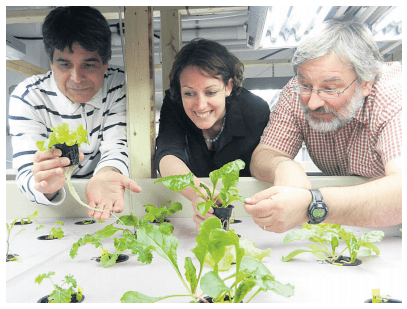
Leaf lettuce being held up; in the background nasturtium, chamomile, yarrow, mint and garden pinks grown with the floating raft technique. Photo: Stacy Murray
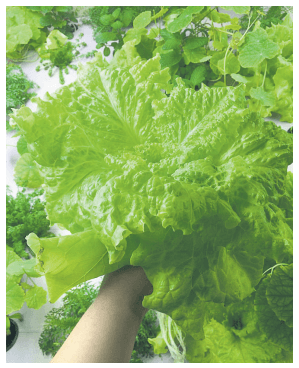
Floating raft technique showing roots below the raft; plants shown are (left to right) mint, leaf lettuce and nasturtium. Photo: Stacy Murray
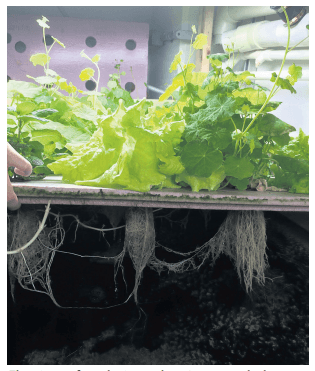
Phosphorus removal from the pilot-scale FIMTA system (a darker blue colour indicates higher levels of phosphorus). On the left, effluent after going through the plant growbed; on the right, effluent before entering the plant grow-bed. Photo: Stacy Murray
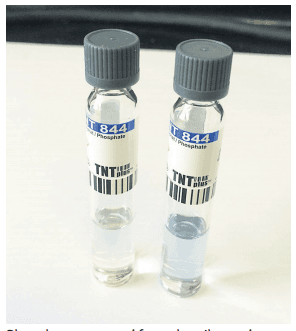
FIMTA floating raft grow-beds showing yarrow, mint, lettuce, chamomile and nasturtium after six weeks of growth at 13-15°C in effluent collected at a commercial salmon hatchery. Photo: Thierry Chopin
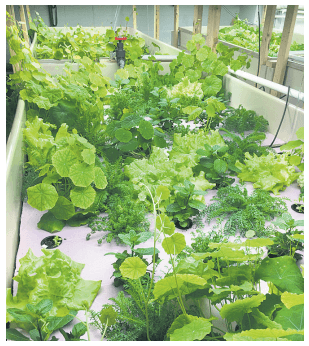
FIMTA Defined
Freshwater Integrated Multi-Trophic Aquaculture (FIMTA) is perhaps better known as “aquaponics.”
FIMTA applies the same principles as those used in marine IMTA (MIMTA) but takes place in a freshwater setting. It is not only important for branding purposes, but can also increase the sustainability of the industry by reducing water usage and waste production, increase product diversification, and improve the societal acceptance of the industry. In particular, using plants to reduce phosphorus (and other nutrient) levels in effluents can help farmers meet water quality guidelines and prevent eutrophication in the environment.
Aquaponics is a form of FIMTA that combines animal aquaculture and plant culture, through a microbial link and in a symbiotic relationship. It uses microbes to convert organic wastes produced by the fish into inorganic nutrients that are then consumed by plants, which also absorb inorganic nutrients that are available directly. This technology can be adapted to many fish- and plant species, in a range of growing conditions, and with a variety of techniques, including the floating raft and mediafilled bed techniques.
This article was originally published in Hatchery International January/February 2016.
Related topics
Authors:
Join to be able to comment.
Once you join Engormix, you will be able to participate in all content and forums.
* Required information
Would you like to discuss another topic? Create a new post to engage with experts in the community.
Create a post


.jpg&w=3840&q=75)